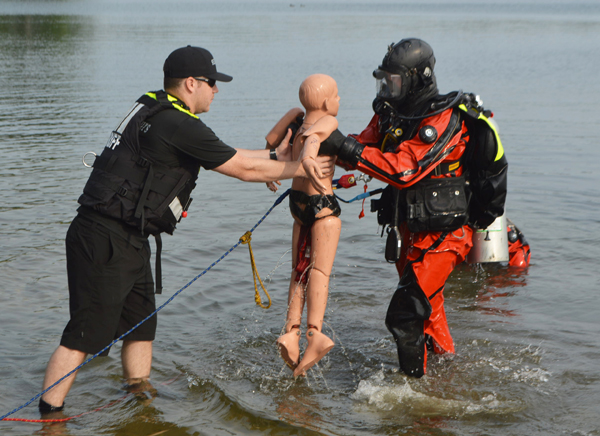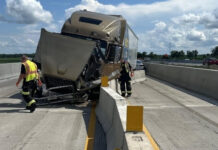
With more than 100 bodies of water in Kosciusko County, local emergency services dive teams need to be prepared to respond to any water emergency.
Dive team members from Warsaw-Wayne Fire Territory – along with members of dive teams from as far away as Wisconsin and New York – finished up the second of four public safety diving classes Sunday morning at Center Lake Park near Nye Youth Cabin with a training scenario.
In Sunday’s scenario, witnesses saw a small boy swimming go under water and not come up. The divers had to find the witnesses and take their statements, triangulate where the boy was likely to be, go into the water and rescue the child, which in this case was a rescue dummy that had been sunk. Once the child was brought to shore, he was given CPR.
On the public safety diving classes, WWFT Lt. Drew Shilling explained, “It’s a series of four classes that we’re hosting from Dive Rescue International, one of the industry leaders in the country.”
Dry Suit Diving was the first class they had, which basically taught the techniques for using the dry suit divers wear, as well as how to handle any emergency procedures.
“The second class, which we’re finishing up today, is Dive Rescue I, and it’s kind of the bread-and-butter operations of public safety diving, doing witness interviews, doing the search patterns to recover victims,” Shilling said.
The instructor for Dive Rescue I was Jerry Richert, a corporate trainer for DRI and the dive commander from Indianapolis Fire. Shilling said he’s been “awesome.”
The next class will be Current Diving, which is diving in rivers and moving water. The fourth class will be Critical Skills Diver, which is “a lot of stress inoculation, how to handle any emergencies you might come through while you’re diving underwater – how to survive and work through those.”
Each class is two to three days. There is some classroom time, but the divers also receive training at the Warsaw Community High School pool and various sites.
“Throughout the course of the series, we’ll have divers – besides us – from Wisconsin, Michigan, Massachusetts, New York and Tennessee. They’re coming from all around,” Shilling said.
There are 10 WWFT guys taking the courses.
“Because we have more than 100 natural bodies of water in our county, not to mention retention ponds, farm ponds that have been dug, the potential for water emergencies is just astronomical,” Shilling said. “[Diving] is a high-risk, low-occurrence – it doesn’t happen often here, but it’s why we have to train so often. It doesn’t happen, so we have to be on top of our game.”
Shilling said they’re fortunate to have the support from the community that they’ve received throughout training. Shadow Lakes housing addition let them use their pond and were very accommodating, Warsaw Community High School has let them use the pool and the fairgrounds let them use the Home & Family Arts Building free of charge.
“We’ve had huge support from the community,” Shilling said.
This is the fourth time WWFT has hosted classes from Dive Rescue International. Shilling said DRI has a whole catalog of courses they teach. Shilling’s goal is to host the classes annually.
“I would like to become like a regional hub, knowing that Warsaw is going to host these classes every year, just because we have so many training sites here with all the water we have,” he said.
Whether they come from Indiana or New York, Shilling said the students in the course are looking for job-specific training. Public safety diving requires recertification ever three years.
“They all probably got their original training from a dive store, which is fine. But this is job specific,” Richert said. “And the main part of this whole thing is, we give them a systematic approach. So, in other words, you’ve got people from all over here right now. But when they’re using the same system, they’re all speaking the same language. They know the approach to it. It’s laid out for them. If they came in from another state, literally, and started working with these guys using the Dive Rescue system, they’re all going to know exactly what to do. So it’s a systematic approach. That’s why they come do it. Job specific.”
Richert started out in Indianapolis as a volunteer firefighter. He then became a career firefighter at a small department. While he was their dive team commander, he also was a recreational scuba instructor and ex-commercial diver. He was running the team as the commander because he was the “resident expert scuba instructor,” but he had no training in public safety diving. While he was doing that, the city of Indianapolis suffered a fatality in dive training. When that happened, Richert realized his dive team and teams all around the city were diving similarly.
Richert’s chief allowed him to go out and do a lot of research on different companies. He chose DRI because they told him they weren’t there to tell him how to run his team but give him tools for his toolbox.
“We changed everything we did at our department at the time,” he said. Unfortunately, the city of Indianapolis had another dive fatality less than two years from the previous one, doing the same thing they were doing the first time.
“Ironically, now, I’m the dive team commander for the city of Indianapolis Fire Department.”
Unfortunately, Richert said, it took that first fatality to give his department a wake-up call that public safety diving was different than all the other diving disciplines.
“It’s important that the training is specific for these guys, public safety,” he said.
Teaching the course the last few days was the first time Richert had been to Warsaw, and he found the city to be “absolutely beautiful.”
“Warsaw Fire Department is hosting the class, and the nice thing is, because of all the bodies of water here … they are already using this system, and they’re doing all the right things as far as equipment, standardization and all this other stuff and they’re continuing their training,” he said.
After Sunday’s scenario, Richert said they found the “victim” within 16 minutes of the 911 call. “That gives that victim a huge chance of possibility of survival. It’s not a guarantee. But that’s the difference. That’s why they call them a dive rescue and not just dive recovery,” he said.
He said a person has a greater chance of survival if they are rescued within one hour, especially in cold water. An hour is a long time, he said, “so that’s why it’s important when the guys get here, they do that witness interview, they’re ready to go, they get in the water and we cut that hour down into a smaller chunk.”
He said they hone their skills so the chance of the victim surviving is greater.
Josh Militello, with the Getzville Fire Company, just outside of Buffalo, N.Y., was one of the divers in Sunday’s scenario.
“So, usually what we’ll do is they’ll start us out at one point out there. They’ll drop you down at the last scene point and then we’ll start our search pattern. So going down, you’re just kind of getting familiar with the bottom, seeing what the bottom conditions are, what you might encounter when you get down there,” he said. “And as soon as you get down, we have communication with the gentleman on the shore, our line tender. So we’re talking with him, seeing which way he wanted me to go. And as soon as I went down, we were able to find the rescue dummy and we brought him in.”
Militello continued, “If it wasn’t like that, where we didn’t have good witnesses, you drop down and you’d start your pattern. So we keep that rope nice and taught, and you’re swimming kind of against the rope, doing like a pendulum pattern, sweeping the bottom, kind of feeling for everything. The smaller the object you’re looking for, the tighter the search. So we’d be doing patterns and start fanning out, or bring us in, depending on what the witnesses said.”
He took the course four years ago and was taking it again this past week as a refresher. He said it provides techniques he will share with the other divers at his department that they all can use.
Tony Shilling, WWFT firefighter who is newer to the dive team, said he learned the importance of patterns and keeping the patterns good. “That’s a big standout to us, and the last scene point is important. And the witnesses are the biggest thing just so we can pinpoint right where the victim is,” he said.
The training helped him feel more confident in his team’s ability to respond and his ability to contribute.




